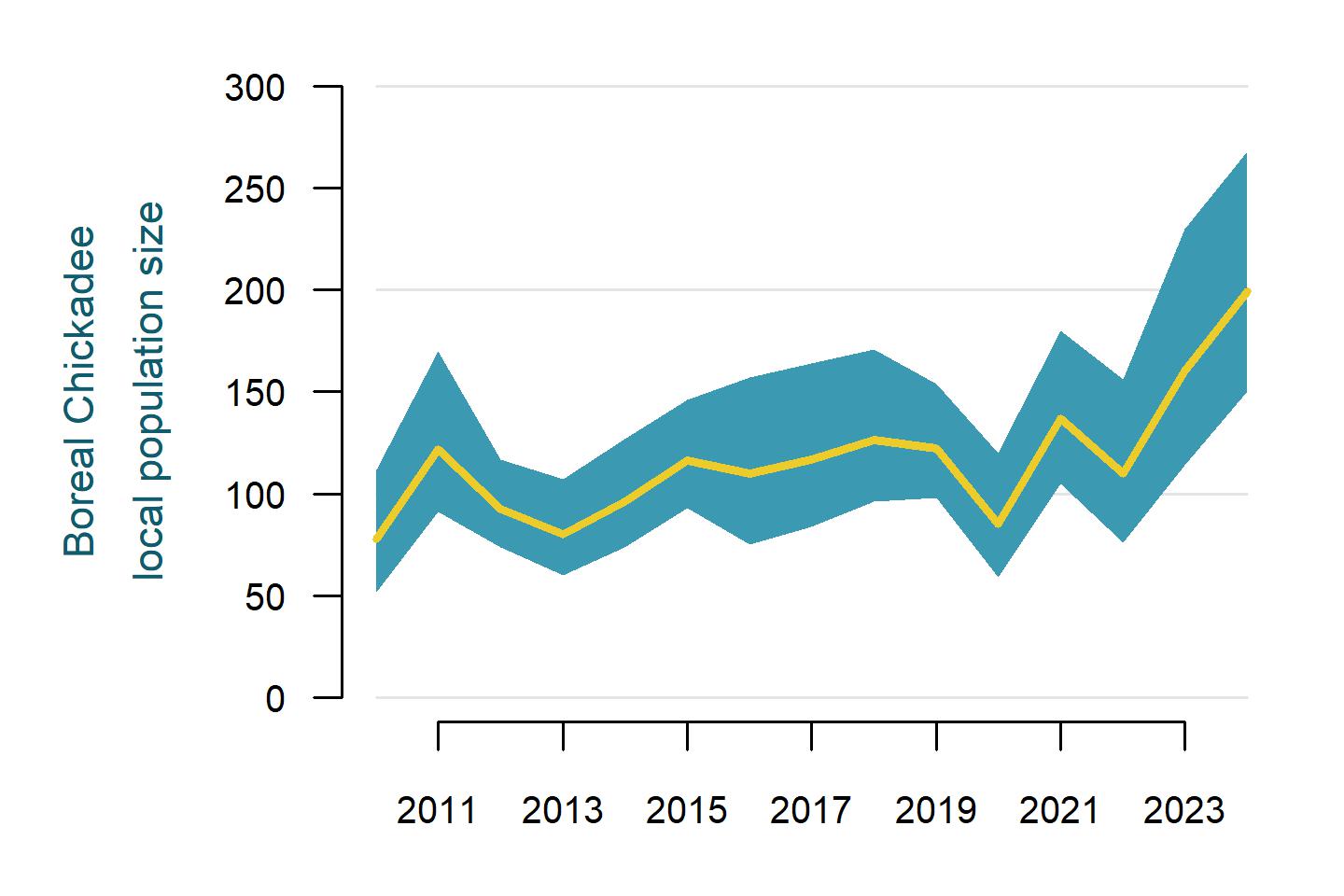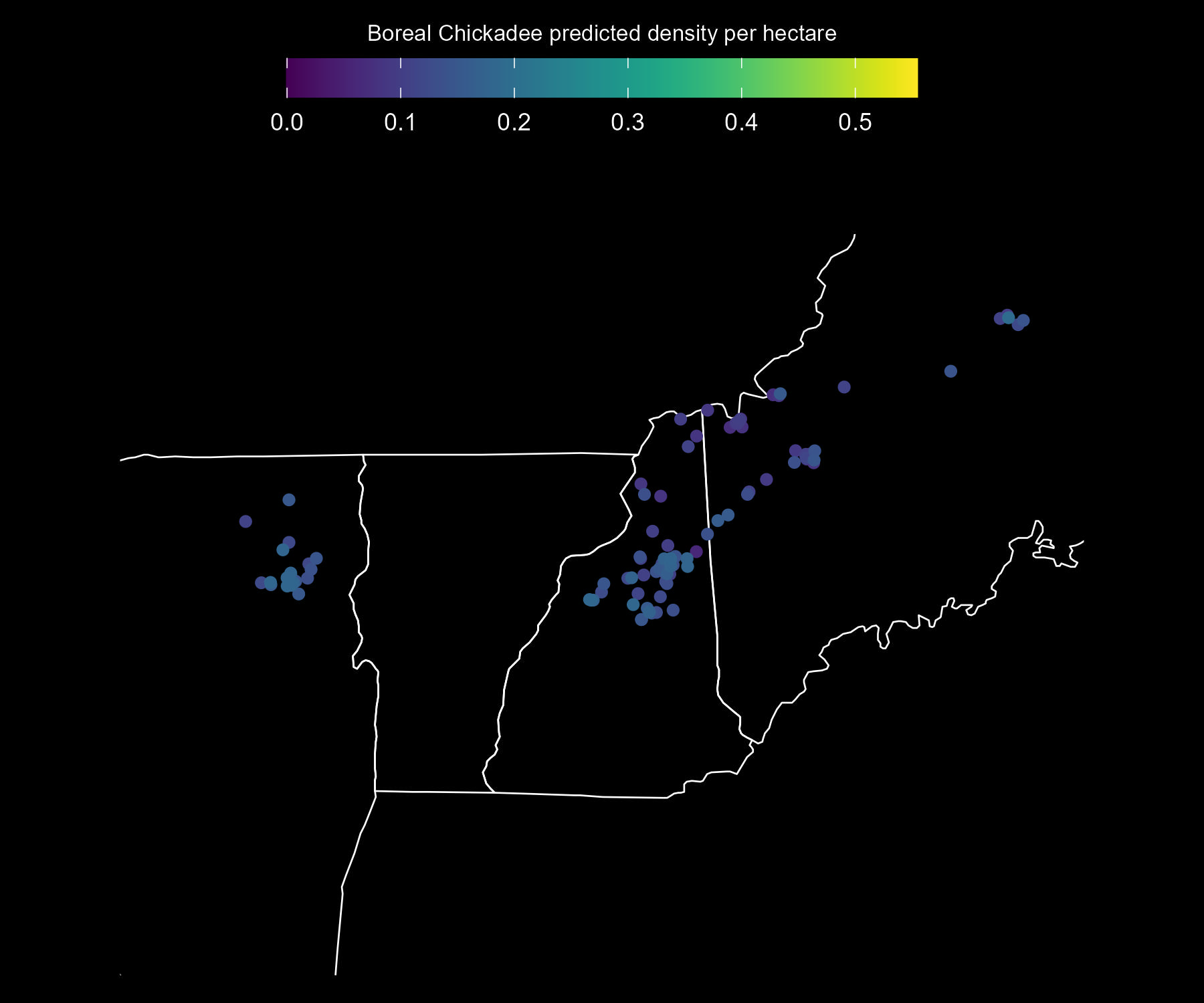The State of Boreal Chickadees
Regionally: Steadily increasing

The mean (thick, yellow line) annual estimate of Boreal Chickadee abundance within the immediate area surrounding all 803 Mountain Birdwatch sampling locations, with a 95% Bayesian credible interval (blue polygon, representing estimate uncertainty).
In our region, sizable populations of Boreal Chickadees only occur in Maine, New Hampshire, and the Adirondacks of New York. They are not known to breed in the Catskills, and are only reliably found in the Northeast Kingdom of Vermont during the summer where they are occasionally detected on the East Mountain Mountain Birdwatch route. Mountain Birdwatch data suggest that Boreal Chickadee populations in the northeastern United States have likely been increasing since 2010 at a mean annual rate of 4.11%. Only a few Boreal Chickadees are detected within Vermont during Mountain Birdwatch, and not in every year; therefore, their population status in Vermont is uncertain, but likely mimics those of the surrounding states. Boreal Chickadees are less conspicuous compared to Black-capped Chickadees, and Boreal Chickadees may maintain large (10-acre) territories where they may move about to find higher densities of food.

Predicted Boreal Chickadee adult density per approximate hectare in an average year (between 2010 and 2024), as estimated from Mountain Birdwatch data. The base map shows the extent of the Mountain Birdwatch region: eastern New York, Vermont, New Hampshire, and western Maine.
| Region | Mean annual trend (%) | Trend (80% CRI) | Probability of decrease | Probability of increase | Population change (%) 2010-2024 | Population change (80% CRI) |
|---|---|---|---|---|---|---|
| All regions | (1.55, 6.49) | 0.02 | 0.98 | 75.81 | (23.98, 141.11) | |
| Maine | (-0.48, 5.38) | 0.12 | 0.88 | 43.32 | (-6.55, 108.35) | |
| New Hampshire | (0.21, 5.91) | 0.07 | 0.93 | 55.02 | (2.97, 123.48) | |
| New York (all regions) | NA (data too sparse) | Unknown | Unknown | Unknown | Unknown | Unknown |
| New York (Adirondacks only) | (4.05, 10.98) | 0.01 | 0.99 | 174.46 | (74.37, 329.87) | |
| New York (Catskills only) | NA (no breeding population) | NA | NA | NA | NA | NA |
| Vermont | NA (data too sparse) | Unknown | Unknown | Unknown | Unknown | Unknown |
Globally: Slightly Declining
Because they occupy remote areas without road access, and because they tend to be quiet and secretive during the breeding season, Boreal Chickadees are not well-monitored by the Breeding Bird Survey. Keeping that in mind, the Breeding Bird Survey data suggest slight declines over the last 50 years in the Eastern U.S., and stable populations in much of Canada. Conversely, eBird trends suggest steady (and in some cases substantial) declines across the southern portion of the Boreal Chickadee breeding range.
Boreal Chickadee habitat is at risk of disappearance due to climate change. Recent climate modeling predicts that >50% of the current range of Boreal Chickadees will be lost over the next 100 years as temperatures increase. By the end of this century, it is probable that Boreal Chickadees will no longer occur in the lower 48 states.


